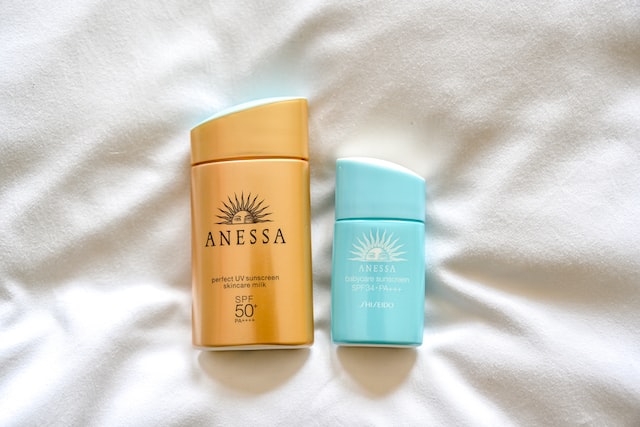Both sunscreen and sunblock are used to protect the skin from ultraviolet radiation. Sunscreen is a chemical product that absorbs UV rays, while sunblock is an opaque substance applied directly to the skin that physically blocks them. Sunblock physically blocks UV rays by forming a barrier on the skin, while sunscreen absorbs UV rays, preventing them from reaching the skin.
What is sunscreen?
There are a lot of misconceptions about sunscreen out there. Some people think that sunblock and sunscreen are the same things, but they’re actually quite different. Sunblock is a physical barrier that reflects or absorbs UV rays, while sunscreen is a chemical compound that absorbs UV rays.
Sunscreen is typically made up of two main ingredients: avobenzone and oxybenzone. Avobenzone protects against UVA rays, while oxybenzone protects against both UVA and UVB rays. Together, these two ingredients provide broad-spectrum protection against the sun’s harmful rays.
Sunscreen should be applied liberally to all exposed skin, including the face, neck, ears, and hands. It should be reapplied every 2 hours, or more frequently if you’re swimming or sweating. And don’t forget to apply it to your lips – look for a lip balm or Chapstick that contains SPF 15 or higher.
Definition of Sunscreen
Sunscreen, on the other hand, is a type of sun protection product that contains chemical ingredients that absorb UV rays before they can reach the skin. Sunscreens tend to be lighter and easier to spread over the skin than sunblocks, making them a popular choice for daily use. However, some sunscreens can contain ingredients that are harmful to the skin, so it is important to read the label and choose products that are safe and effective.
What is sunblock?
Sunblock is a physical sunscreen that works by reflecting and scattering UV rays away from the skin. It usually contains zinc oxide or titanium dioxide, which are natural minerals that offer broad-spectrum protection against both UVA and UVB rays. Sunblock’s tend to be thicker in consistency and can leave a white cast on the skin, which is why they’re often used for beach days or outdoor activities.
Definition of Sunblock
Sunblock is a type of sun protection product that physically blocks the sun’s UV rays from reaching the skin. This type of product usually contains active ingredients like titanium dioxide or zinc oxide, which reflect or scatter the sun’s rays to prevent sunburn, skin damage, and skin cancer. Sunblock’s tend to be thicker and heavier in consistency than sunscreens, which can make them difficult to spread evenly over the skin. However, they tend to be more effective at blocking UV rays and offer more protection against the sun.
The difference between sunblock and sunscreen
(Photo by yue su on Unsplash )

When it comes to sun protection, many people are unsure of the difference between sunblock and sunscreen. Both products serve the same purpose, but there are some key differences that you should be aware of.
Sunblock is a physical barrier that reflects and scatters UV rays away from the skin. It usually contains active ingredients like zinc oxide or titanium dioxide. Sunscreen, on the other hand, uses chemicals to absorb UV rays before they reach the skin.
One of the main advantages of sunblock is that it provides broad-spectrum protection against both UVA and UVB rays. Sunscreen typically only protects against UVB rays, so it’s not as effective in preventing sun damage.
Another difference is that sunblock is less likely to cause irritation or allergic reactions than sunscreen. This is because it doesn’t contain any chemicals that can penetrate the skin. However, some people may still be sensitive to certain ingredients in sunblock, so it’s always best to test a small area first before applying it liberally.
Finally, sunblock generally lasts longer on the skin than sunscreen. This means you won’t have to reapply it as often, which is convenient if you’re spending a long day outdoors.
Differences in Functionality
The main difference between sunblock and sunscreen is the way they function. Sunblock’s physically block UV rays from reaching the skin, while sunscreens absorb UV rays before they can do damage. This means that sunblocks tend to provide more protection against the sun, but can be harder to apply and more difficult to wear. Sunscreens, on the other hand, are easier to wear and less noticeable on the skin, but may not provide as much protection as sunblocks.
Differences in Ingredients
Another key difference between sunblock and sunscreen is the ingredients used in each product. Sunblocks tend to contain active ingredients like titanium dioxide or zinc oxide, which physically block UV rays from reaching the skin. Sunscreens, on the other hand, contain chemical ingredients like avobenzone, oxybenzone, and homosalate, which absorb UV rays before they can do damage. Some sunscreens may also contain fragrances, oils, and other ingredients that can irritate the skin, so it is important to choose products that are safe and effective.
How to choose the right sunscreen for you
(Photo by Corina Nicolae on Unsplash )

The answer really depends on your individual needs and preferences. If you have sensitive skin, a sunblock may be a better choice because it physically blocks UV rays and does not contain harsh chemical ingredients. If you are looking for an easier and more convenient way to protect your skin, a sunscreen may be a better choice. The important thing is to choose a product that provides adequate protection from the sun and does not contain ingredients that are harmful to your skin.
Here are a few things to consider when choosing a sunscreen:
Your skin type: If you have sensitive skin, you may want to opt for a physical sunblock.
The level of SPF: The higher the SPF, the better protection you’ll have from the sun. However, don’t forget to reapply!
Water resistance: If you’re going to be swimming or sweating, make sure to choose a water-resistant sunscreen.
Ingredients: Take a look at the ingredients list to see if there’s anything you’re allergic to or would prefer to avoid.
Can sunscreen and sunblock both be used together?
Yes, sunscreen and sunblock can both be used together to provide a double layer of protection from the sun’s UV rays. By using both products, you can physically block UV rays with the sunblock and absorb them with the sunscreen, giving you the best possible protection from the sun. However, it is important to choose products that are compatible and work well together, and to use them as directed for maximum effectiveness.
Can sunblock damage your skin?
Sunblock itself does not damage your skin. However, if not used properly, sunblock can lead to skin irritation, redness, and breakouts. This can happen if the sunblock is not applied evenly, if it is not reapplied as needed, or if it is not compatible with your skin type. To avoid these issues, it is important to choose a sunblock that is appropriate for your skin type, to apply it evenly and as directed, and to reapply it as needed, especially after sweating, swimming, or toweling off. Additionally, it is important to seek out sunblock products that are free of harsh chemicals and fragrances that can cause skin irritation.
Can I apply sunscreen directly on face?
Yes, you can apply sunscreen directly on your face. In fact, it is recommended to do so in order to fully protect your face from the sun’s damaging UV rays. When applying sunscreen on your face, it is important to choose a product that is specifically formulated for the face, as these products are often lighter and gentler on the skin, and they may also contain additional ingredients to protect and nourish the delicate skin on your face. Additionally, it is important to apply the sunscreen evenly and generously, taking care to cover all exposed areas, including your neck, ears, and the top of your head if you have thinning or no hair. Be sure to reapply the sunscreen every two hours or immediately after swimming or sweating.
Why does my skin gets dark after applying sunscreen?
Sunscreen can sometimes cause skin discoloration or darkening, also known as post-inflammatory hyperpigmentation (PIH). This is because some sunscreens contain ingredients that can irritate or sensitize the skin, leading to an overproduction of melanin, the pigment that gives skin its color. Additionally, sunscreens can also cause phototoxicity, meaning that they can increase skin sensitivity to the sun, leading to increased production of melanin. If you are experiencing skin darkening after using sunscreen, you may want to consider switching to a gentler, non-irritating formula or using a physical sunblock with titanium dioxide or zinc oxide instead. It is also important to always patch test new products before using them all over your face to avoid adverse reactions.
If you’re concerned about your skin getting dark after applying sunscreen, there are a few things you can do to prevent it. First, make sure you’re using a broad-spectrum sunscreen that offers protection against both UVA and UVB rays. Second, apply sunscreen generously and evenly to all exposed areas of skin. Third, reapply sunscreen every two hours or after swimming or sweating. And fourth, try using a physical sunblock instead of a chemical one. Physical sunblocks rely on minerals like zinc oxide and titanium dioxide to reflect UV rays away from your skin, and they’re less likely to cause your skin to darken.
The types of sunscreen
Sunscreen is a lotion, spray, gel, or other topical product that helps protect the skin from the sun’s ultraviolet (UV) rays.
There are two main types of sunscreen: Physical and Chemical.
Physical sunscreen works by reflecting and scattering UV rays away from the skin.
Chemical sunscreen works by absorbing UV rays and then releasing them as heat.
Most sunscreens contain a combination of both physical and chemical ingredients. However, there are also some all-natural sunscreens that only use physical ingredients like zinc oxide or titanium dioxide.
When choosing a sunscreen, it’s important to look for one that has an SPF of 30 or higher and provides broad-spectrum protection against both UVA and UVB rays. Water resistance is also a good feature to look for if you’ll be spending time in the water or sweating heavily.
The types of sunblock
There are two main types of sunblock: physical and chemical.
Physical Sunblock: Also known as mineral sunblock, physical sunblock contains active mineral ingredients, such as titanium dioxide and zinc oxide, which sit on the surface of the skin and reflect UV rays. Physical sunblock is generally gentler on the skin and less likely to cause irritation or sensitivity compared to chemical sunblock.
Chemical Sunblock: Chemical sunblock contains active chemical ingredients, such as oxybenzone, avobenzone, and homosalate, that work by absorbing UV rays and converting them into heat, which is then released from the skin. Chemical sunblock is often lighter and more cosmetically appealing than physical sunblock, but it can be more irritating to the skin and may cause allergic reactions in some people.
The advantages and disadvantages of sunscreen and sunblock
Advantages of using sunscreen/sunblock:
- Protects against skin damage: Sunscreen/sunblock protects the skin from harmful UV rays that can cause sunburn, skin aging, and increase the risk of skin cancer.
- Prevents dark spots: Sunscreen/sunblock helps to prevent the formation of dark spots and other forms of hyperpigmentation caused by sun exposure.
- Reduces skin aging: Regular use of sunscreen/sunblock can slow down the process of skin aging, reducing the appearance of fine lines and wrinkles.
- Water-resistant: Many sunscreens/sunblocks are water-resistant, making them ideal for outdoor activities and water sports.
Disadvantages of using sunscreen/sunblock:
- Can be greasy: Some sunscreens/sunblocks can leave a greasy or heavy feeling on the skin, which may not be suitable for all skin types.
- Can cause skin irritation: Some sunscreens/sunblocks contain ingredients that can irritate sensitive skin, causing redness, itching, and breakouts.
- May contain harmful ingredients: Some sunscreens/sunblocks contain ingredients that may be harmful to the skin or the environment.
- Can interfere with vitamin D production: Sunscreen/sunblock can prevent the skin from producing vitamin D, which is essential for good health.
It is important to choose a sunscreen/sunblock that is appropriate for your skin type and to apply it as directed for maximum protection against UV rays. It is also important to avoid excessive sun exposure and to seek shade when the sun is at its strongest.
What are the side effects of sunscreen and sunblock?
Side effects of using sunscreen/sunblock can vary depending on the type and ingredients used. Some common side effects include:
- Skin irritation: Some people may experience skin irritation, redness, itching, or breakouts when using sunscreen/sunblock. This may be due to the presence of certain ingredients, such as fragrances, preservatives, or PABA.
- Allergic reactions: Some people may experience an allergic reaction to ingredients in sunscreen/sunblock, such as oxybenzone, avobenzone, or octinoxate. Symptoms may include itching, redness, hives, or swelling.
- Vitamin D deficiency: Overuse of sunscreen/sunblock can prevent the skin from producing vitamin D, which is essential for good health.
- Environmental concerns: Some sunscreens/sunblocks contain ingredients that may be harmful to marine life and coral reefs, such as oxybenzone and octinoxate.
It is important to choose a sunscreen/sunblock that is appropriate for your skin type and to apply it as directed to minimize the risk of side effects. If you experience any symptoms of skin irritation or an allergic reaction, discontinue use and seek medical advice.
What is SPF in relation to sunscreen and sunblock?
SPF stands for Sun Protection Factor and it is a measure of the effectiveness of a sunscreen or sunblock in protecting the skin from harmful UV rays. The SPF number indicates the amount of time that a person can spend in the sun without getting burned, compared to how quickly they would get burned without any protection.
For example, if it takes a person 10 minutes to get a sunburn without protection, using a sunscreen with an SPF of 30 would theoretically allow them to stay in the sun for 30 times longer (10 x 30 = 300 minutes) without getting burned.
It’s important to note that the SPF number only indicates protection against UVB rays, which are the main cause of sunburn. UVA rays, which penetrate deeper into the skin and contribute to skin aging and cancer, are not as well protected by sunscreens. To ensure maximum protection against both UVB and UVA rays, it is recommended to choose a broad-spectrum sunscreen with a high SPF.
What is the recommended SPF for sunscreen and sunblock
The recommended SPF, or sun protection factor, for sunscreen is 15. This means that the sunscreen will protect your skin from 93% of the sun’s UVB rays. The SPF for sunblock is 30. This means that the sunblock will protect your skin from 97% of the sun’s UVB rays.
When and where should you use sunscreen and sunblock?
Sunscreen or sunblock should be used whenever you are exposed to direct sun exposure, regardless of the weather conditions or time of year. Some specific situations where it is especially important to use sunscreen or sunblock include:
- Outdoor activities: When participating in outdoor activities such as hiking, gardening, sports, or water activities, it is important to apply sunscreen or sunblock to protect the skin from UV rays.
- High altitude or tropical climates: In high altitude or tropical climates, UV rays are stronger and more intense, making it even more important to use sunscreen or sunblock.
- Beach or water activities: When participating in beach or water activities, it is important to choose a water-resistant sunscreen or sunblock to ensure maximum protection against UV rays, especially when swimming or sweating.
- During the peak sun hours: UV rays are the strongest between 10 am and 4 pm, so it is especially important to use sunscreen or sunblock during these hours.
Sunscreen or sunblock should be applied liberally to all exposed skin, including the face, neck, arms, legs, and ears. It should be reapplied every 2 hours, or immediately after swimming or sweating. It is also important to seek shade when the sun is at its strongest, and to wear protective clothing, such as hats and sunglasses.
Featured Image By – Photo by Arthur Pereira on Unsplash








